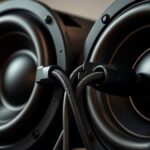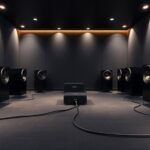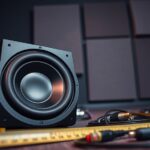To stop your subwoofer from canceling itself, start by checking its phase setting—try flipping the phase switch or adjusting the phase control while listening for stronger, deeper bass. Make sure your subwoofer is placed near your main speakers and away from walls or corners to improve timing. Properly align your crossover and avoid wiring mistakes. If you continue exploring, you’ll discover more tips to perfectly tune your system for powerful, clear sound.
Key Takeaways
- Use the subwoofer’s phase inversion switch and listen for improved bass clarity and punch.
- Set your receiver’s phase control to 0°, then adjust while listening for the strongest, most centered bass.
- Experiment with subwoofer placement near main speakers, avoiding corners and walls to reduce phase cancellation.
- Play test tones or bass-heavy music to identify hollow or weak bass, adjusting phase accordingly.
- Check and correct speaker wiring polarity to ensure proper phase alignment and prevent cancellation.
Understanding the Basics of Phase in Audio Systems
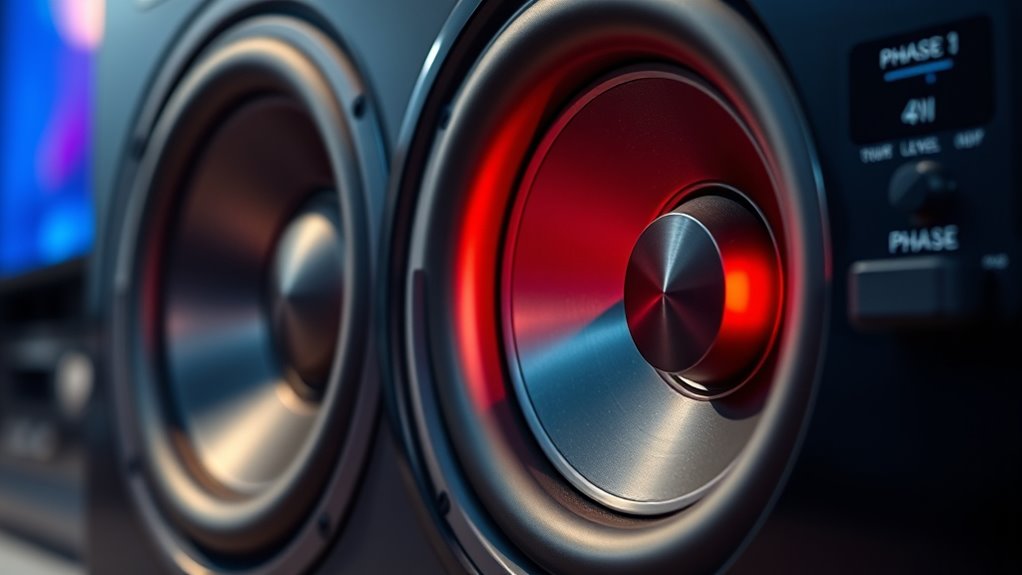
Understanding the basics of phase in audio systems is essential because it influences how sound waves combine and how accurately you hear audio. When your subwoofer’s placement affects the timing of sound waves reaching your ears, phase shift can occur. This shift causes waves to either reinforce or cancel each other, impacting sound clarity. If the subwoofer is out of sync with your main speakers, you might notice muffled bass or uneven sound. Proper subwoofer placement helps minimize unwanted phase shift, ensuring sound waves arrive in phase and blend smoothly. Recognizing how phase works allows you to fine-tune your system for ideal audio performance. Proper placement also plays a crucial role in preventing phase issues, leading to a more cohesive listening experience. High refresh rates in projectors can also affect how smoothly images are displayed, similar to how phase affects sound quality. By paying attention to phase, you can prevent cancellations that diminish your listening experience and enhance overall sound quality. Additionally, understanding phase alignment helps in troubleshooting audio problems and achieving optimal sound clarity. Knowing about frequency response can further assist in adjusting your system for balanced sound reproduction.
How Phase Cancellation Affects Your Sound Quality
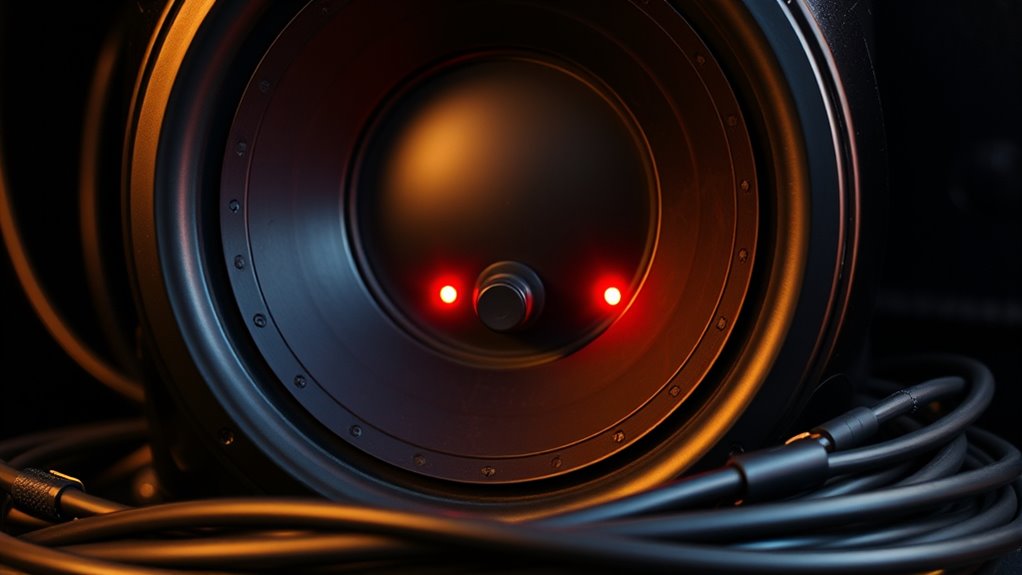
When sound waves are out of sync, they can cancel each other out, causing poor audio clarity. This interference often results from subwoofer timing issues that disrupt the balance of your sound system. Understanding how phase cancellation impacts your listening experience helps you make better adjustments for clearer, more accurate audio. Proper phase alignment ensures your subwoofer and speakers work harmoniously, preventing sound cancellation and optimizing overall sound quality. Using tools like a phase tester can assist in achieving precise alignment for the best sound performance. Additionally, certain aftermarket audio components designed for tuning can help fine-tune the phase relationship between speakers and subwoofers. Given the importance of sound quality, ongoing research into AI-driven audio correction techniques is advancing the accuracy of phase adjustments. Maintaining awareness of environmental acoustics can further improve your overall audio experience by reducing unwanted reflections and echoes.
Sound Wave Interference
Sound wave interference occurs when two or more sound waves meet, causing them to combine in ways that can either amplify or diminish the resulting sound. When waves are in phase, they reinforce each other, boosting volume and improving frequency response. Conversely, out-of-phase waves cancel each other out, leading to dead spots or reduced sound clarity. This interference heavily depends on your speaker placement, as positioning influences how sound waves interact. If your subwoofer and main speakers aren’t aligned properly, phase cancellation can distort your sound, especially at certain frequencies. To maintain the best possible sound quality, you need to think about both the phase of your speakers and their placement. Proper alignment prevents destructive interference, ensuring a balanced, full-frequency response and a better listening experience. Additionally, understanding sound recording techniques can help you identify and correct phase issues during setup. Being aware of your room acoustics and how sound waves reflect can also help mitigate unwanted sound wave interference and optimize your audio setup. Regularly checking your speaker settings and using phase adjustment tools can further enhance sound clarity and prevent cancellation issues. Recognizing the importance of speaker placement can help you avoid common problems associated with phase cancellation, and utilizing sound analysis tools can assist in fine-tuning your system for optimal performance.
Subwoofer Timing Issues
Ever wondered why your bass sometimes sounds thin or boomy despite having a powerful subwoofer? Timing issues can cause phase cancellation, impacting sound quality. If your subwoofer isn’t properly aligned with your main speakers, you’ll notice gaps or muddiness in bass response. Adjusting subwoofer placement helps, as placing it too close to walls or corners can delay sound waves. Also, check your crossover settings; if they’re too high or low, it can create timing mismatches. Proper placement and correct crossover tuning keep your bass tight and balanced. Additionally, understanding phase alignment techniques can help you fine-tune your system for optimal sound. Recognizing the importance of speaker positioning can further improve your overall audio quality and reduce phase issues. Consulting support hours from your audio equipment provider can also assist in troubleshooting complex phase problems. Moreover, ensuring your sound system components are compatible can prevent timing discrepancies that lead to cancellation. Being aware of acoustic environment factors is also crucial, as room acoustics significantly influence phase interactions.
Impact on Audio Clarity
Have you noticed that sometimes your music or movie sounds muffled or lacks punch? That’s often due to phase cancellation, which directly impacts audio clarity. Poor subwoofer placement can cause sound waves to cancel out, making bass seem weak or distorted. When your subwoofer isn’t properly aligned with your main speakers, certain frequencies may interfere destructively. Additionally, amplifier compatibility plays a role—an incompatible or mismatched amplifier can worsen phase issues, reducing overall sound quality. Correcting phase alignment ensures sound waves reinforce rather than cancel each other, resulting in clearer, more precise audio. Proper placement and compatible equipment allow your subwoofer to work harmoniously with your system, delivering the full depth and punch of your audio without muffling or muddiness. Consulting with regional audio specialists can help you achieve optimal sound quality through proper setup, especially as market growth projected at over 40% CAGR in AI tech by 2025 continues to influence audio technology advancements.
Identifying Signs of Incorrect Phase Alignment

Incorrect phase alignment often manifests through noticeable audio issues that can compromise your overall sound quality. You might notice a hollow or thin bass, with sounds seeming disconnected or muddy. Clapping or test tones may reveal dips in volume or weak low frequencies, signaling phase problems. Poor cable management can cause loose connections, exacerbating phase issues, so verify cables are secure. Additionally, improper speaker placement—like positioning speakers too close or at uneven angles—can lead to phase cancellation. If your subwoofer’s sound lacks punch or seems to cancel out other speakers, these are clear signs of incorrect phase alignment. Recognizing these signs early helps you identify the need to check your setup before adjusting phase settings. Understanding how tuning software influences speaker calibration can also help in diagnosing and correcting phase issues more effectively. Proper system tuning ensures optimal sound performance and prevents phase cancellation problems.
Methods to Check the Phase of Your Subwoofer
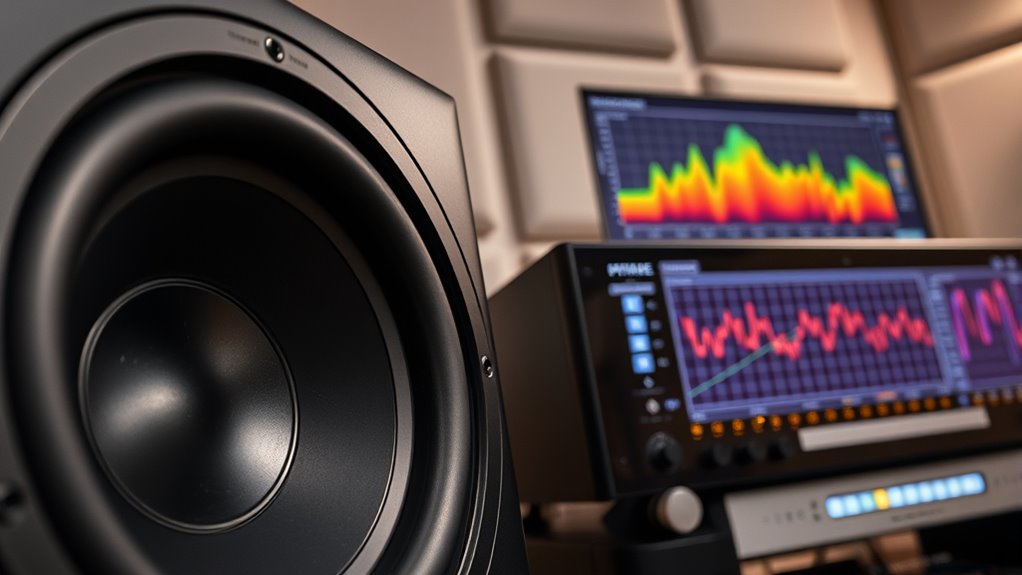
To accurately determine if your subwoofer’s phase is properly aligned, you need clear methods to test it. Proper subwoofer placement and cable polarity are key factors to consider. Here are three effective ways to check the phase:
- Listen for Bass Clarity: Play a familiar track with deep bass. If the bass sounds hollow or disconnected, the phase might be off.
- Use a Phase Test Tone: Play a test tone and listen for the loudest, most centered bass; if it’s weak, the phase could be misaligned.
- Check Cable Polarity: Ensure your subwoofer cable is connected with correct polarity. Reversing the cable can cause phase cancellation issues.
These methods help confirm if your subwoofer’s phase is aligned for ideal sound.
Adjusting Phase Settings on Your Subwoofer and Receiver
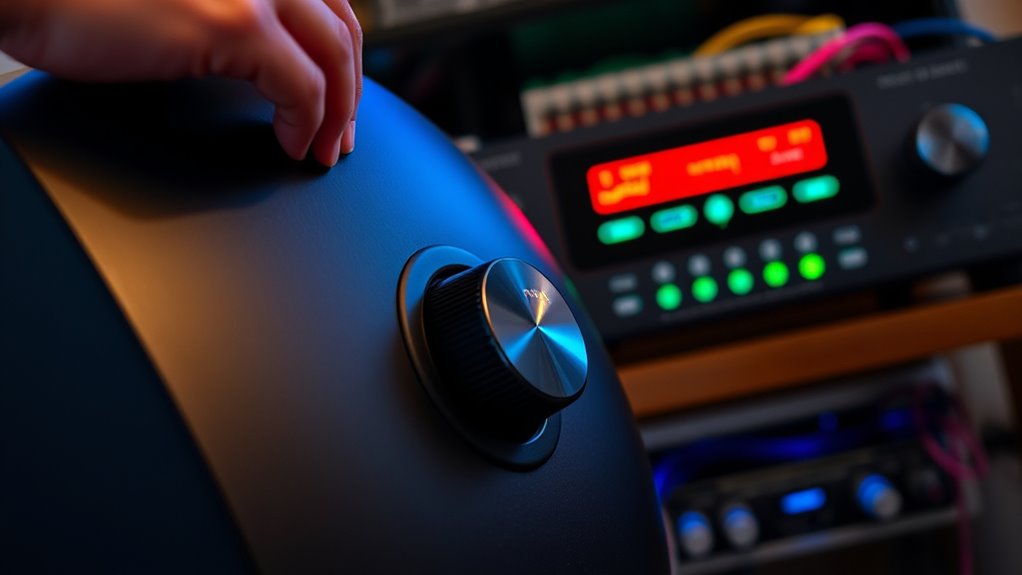
Adjusting the phase settings on your subwoofer and receiver is essential for achieving seamless bass integration with your main speakers. Proper subwoofer placement can influence how phase interacts with your system, so experiment with positioning to find the best sound. Many subwoofers feature a phase inversion switch, allowing you to reverse the subwoofer’s polarity. Start by setting your receiver’s phase control to 0°, then listen to the bass. If it sounds weak or hollow, flip the phase inversion switch on your subwoofer and compare again. Continue adjusting both the receiver’s phase setting and subwoofer placement until the bass feels cohesive and punchy. This process helps eliminate cancellations, ensuring your subwoofer complements your main speakers perfectly.
Tips for Achieving Proper Phase Alignment for Deep Bass

Achieving proper phase alignment for deep bass requires careful listening and precise adjustments. Your goal is to ensure the woofer placement and crossover settings work together seamlessly. Here are three tips to help:
- Optimize Woofer Placement: Position your subwoofer near your main speakers, avoiding corners or walls that might cause phase issues.
- Adjust Crossover Settings: Set the crossover frequency so that the subwoofer and main speakers blend smoothly, reducing phase cancellation.
- Use Test Tones or Music: Listen for deep bass clarity. Slightly tweak the phase control or placement until bass sounds full and centered, avoiding hollow or canceled effects.
Properly aligning these elements ensures your deep bass is punchy, balanced, and free from cancellation.
Troubleshooting Common Phase-Related Sound Issues
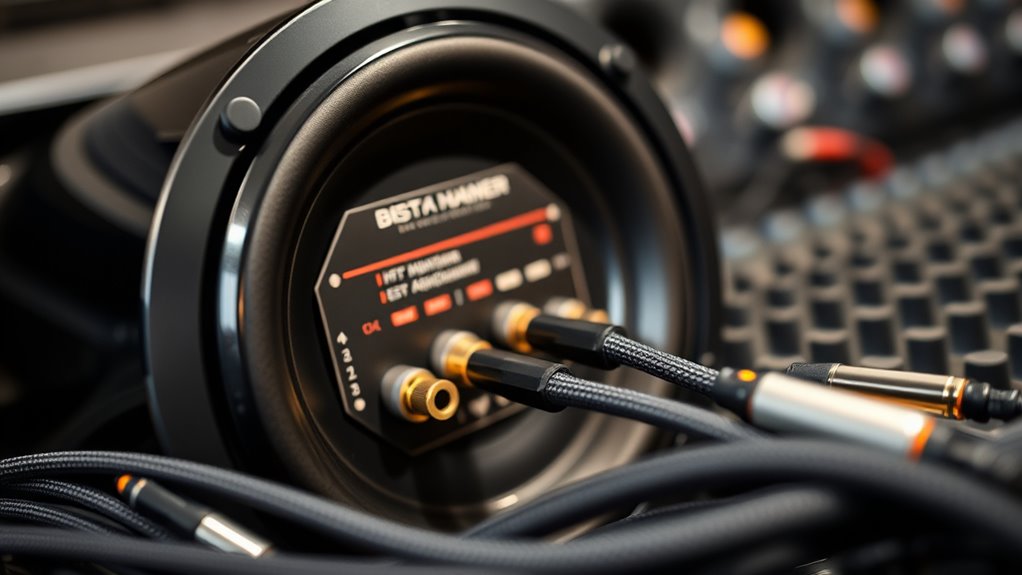
When phase issues occur, you might notice a hollow or muffled bass, or a lack of punch that disrupts overall sound clarity. One common cause is phase inversion, where the speaker’s polarity is reversed, causing sound waves to cancel each other out. This cancellation leads to weaker bass and poor low-frequency response. Sound bleed from nearby speakers can also cause phase problems, especially if they’re out of sync. To troubleshoot, start by flipping the subwoofer’s phase switch or adjusting its phase control to see if the bass tightens and becomes more focused. If you notice improved sound, you’ve identified a phase issue. Always check your speaker wiring and placement, as incorrect wiring or overlapping sound waves can exacerbate phase cancellation.
Frequently Asked Questions
Can Phase Issues Damage My Audio Equipment?
Phase issues typically won’t cause audio damage or threaten your equipment safety. Instead, they mainly affect sound quality, causing muffled or weak bass. However, if you ignore phase problems and keep pushing your system, it could lead to unnecessary strain on your amplifier or speakers, potentially risking damage over time. To protect your gear and enjoy peak sound, it’s best to address phase alignment issues promptly.
How Often Should I Check My Subwoofer’s Phase?
You should check your subwoofer’s phase whenever you notice changes in sound quality or after repositioning it. Regularly verifying helps prevent phase mismatch, which can cause dips in your frequency response and reduce overall sound clarity. Ideally, check monthly or after any major setup adjustments. Simple tests like listening for bass clarity or using a phase test tone can help guarantee your subwoofer stays properly aligned for ideal performance.
Is Phase Alignment Necessary With All Speaker Setups?
Think of your speaker setup as a dance where harmony matters. While phase alignment isn’t always necessary, it’s essential if your speaker placement or room acoustics cause sound waves to clash. When these elements are misaligned, your audio can sound hollow or muffled. In such cases, adjusting the phase ensures your subwoofer and speakers work together smoothly, creating a balanced, immersive sound experience.
What Tools Are Best for Measuring Phase Accuracy?
When measuring phase accuracy, you want reliable measurement tools, like phase meters, that give precise readings. These tools help you identify whether your subwoofer and speakers are aligned correctly, ensuring smooth sound. Opt for digital phase meters for quick, accurate results, or use a multimeter with phase measurement capabilities if you prefer versatility. Proper tools make it easier to fine-tune your setup and avoid cancellation issues.
Can Software Automatically Correct Phase Problems?
You might wonder if software can automatically fix phase issues. The answer is yes, digital calibration often includes phase correction tools that analyze your system and make adjustments automatically. These tools detect phase discrepancies and fine-tune your subwoofer’s timing, ensuring better sound coherence. Using digital calibration saves you time and effort, helping you achieve ideal phase alignment without manual tweaking, and ultimately improving your overall audio experience.
Conclusion
Getting your subwoofer’s phase right can make a huge difference in your sound quality. Did you know that incorrect phase alignment can reduce bass response by up to 50%? By understanding and adjusting the phase properly, you’ll enjoy clearer, deeper bass without cancellations. Take the time to check and fine-tune your setup—your ears will thank you with richer, more immersive audio. Proper phase alignment is the key to truly powerful, balanced sound in your system.


